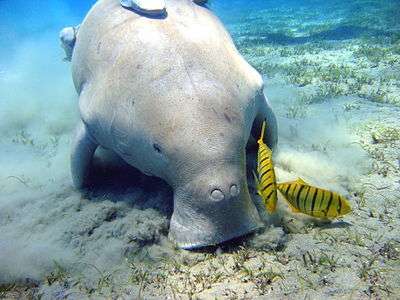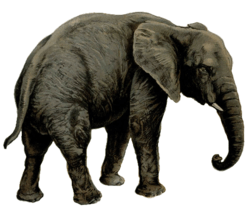Dugongidae
The Dugongidae are a family in the order of Sirenia. The family has one surviving species, the dugong (Dugong dugon), one recently extinct species, Steller's sea cow (Hydrodamalis gigas), and a number of extinct genera known from fossil records.

Dugong skeleton displayed at Philippine National Museum
| Dugongidae[1] Temporal range: Late Eocene-Holocene | |
|---|---|
 | |
| A dugong in Marsa Alam | |
| Scientific classification | |
| Kingdom: | Animalia |
| Phylum: | Chordata |
| Class: | Mammalia |
| Order: | Sirenia |
| Family: | Dugongidae Gray, 1821 |
| Genera | |
|
Dugong | |
Taxonomy
- Family DUGONGIDAE
- Genus †Anisosiren
- Genus †Caribosiren
- Genus †Indosiren
- Genus †Lentiarenium
- Genus †Kaupitherium[2]
- Genus †Paralitherium
- Genus †Priscosiren[3]
- Genus †Prohalicore
- Genus †Sirenavus
- Subfamily †Halitheriinae
- Genus †Halitherium (nomen dubium)
- Subfamily Dugonginae
- Genus †Bharatisiren
- Genus †Callistosiren[4]
- Genus †Crenatosiren
- Genus †Corystosiren
- Genus †Culebratherium
- Genus †Dioplotherium
- Genus †Domningia
- Genus Dugong
- Species Dugong dugon, dugong
- Genus †Italosiren[5]
- Genus †Kutchisiren
- Genus †Nanosiren
- Genus †Norosiren
- Genus †Rytiodus
- Genus †Xenosiren
- Subfamily †Metaxytheriinae
- Genus †Metaxytherium
- Subfamily †Hydrodamalinae
- Genus †Dusisiren
- Genus †Hydrodamalis
- Species †Hydrodamalis cuestae
- Species †Hydrodamalis spissa[6]
- Species †Hydrodamalis gigas, Steller's sea cow
The genera Eosiren, Eotheroides, and Prototherium have been assigned to Halitheriinae in the past, but recent cladistic analysis recovers these genera as basal to the clade formed by Trichechidae and Dugongidae. Moreover, Halitheriinae is paraphyletic with respect to Dugonginae and Hydrodamalinae, and further use of the name should be discontinued because the type genus is based on a non-diagnostic tooth.[7]
Phylogeny
| Afrotheria |
| ||||||||||||||||||||||||||||||||||||||||||
gollark: This is ... odd.
gollark: Ah, I sorted by "latest", NOW I see it.
gollark: I searched Twitter for "telecommuting into DC" and it... seems to be people talking about people saying those "telecommuting into DC" messages a lot, but none of the actual tweets pictured?
gollark: Where did you get *that* from?
gollark: ... what?
References
- Shoshani, J. (2005). Wilson, D.E.; Reeder, D.M. (eds.). Mammal Species of the World: A Taxonomic and Geographic Reference (3rd ed.). Johns Hopkins University Press. ISBN 978-0-8018-8221-0. OCLC 62265494.
- Manja Voss & Oliver Hampe (2017). "Evidence for two sympatric sirenian species (Mammalia, Tethytheria) in the early Oligocene of Central Europe". Journal of Paleontology. in press. doi:10.1017/jpa.2016.147.
- Vélez-Juarbe, Jorge; Domning, Daryl P. (2014). "Fossil Sirenia of the West Atlantic and Caribbean region. X. Priscosiren atlantica, sp. nov". Journal of Vertebrate Paleontology. 34 (4): 951. doi:10.1080/02724634.2013.815192.
- Vélez-Juarbe, Jorge; Domning, Daryl P. (2015). "Fossil Sirenia of the West Atlantic and Caribbean region. XI. Callistosiren boriquensis, gen. et sp. nov". Journal of Vertebrate Paleontology. 35: e885034. doi:10.1080/02724634.2014.885034.
- Manja Voss; Silvia Sorbi; Daryl P. Domning (2017). "Morphological and systematic re-assessment of the late Oligocene "Halitherium" bellunense reveals a new crown group genus of Sirenia". Acta Palaeontologica Polonica. 62 (1): 163–172. doi:10.4202/app.00287.2016.
- Furusawa, Hitoshi (1988). A new species of hydrodamaline Sirenia from Hokkaido, Japan. Takikawa Museum of Art and Natural History. pp. 1–73.
- Voss, Manja (2014). "On the invalidity of Halitherium schinzii Kaup, 1838 (Mammalia, Sirenia), with comments on systematic consequences". Zoosystematics and Evolution. 90: 87–93. doi:10.3897/zse.90.7421.
This article is issued from Wikipedia. The text is licensed under Creative Commons - Attribution - Sharealike. Additional terms may apply for the media files.
